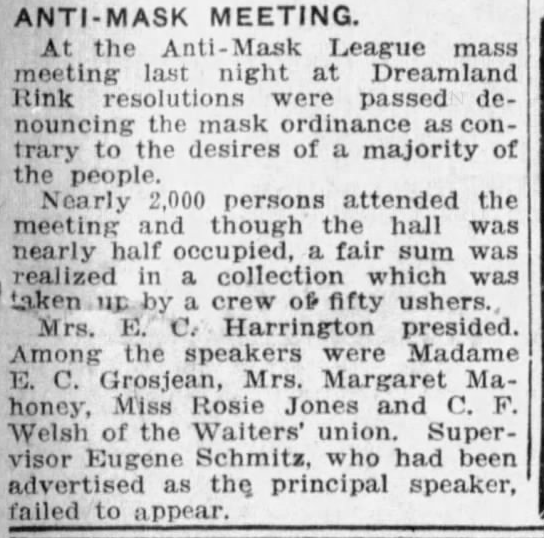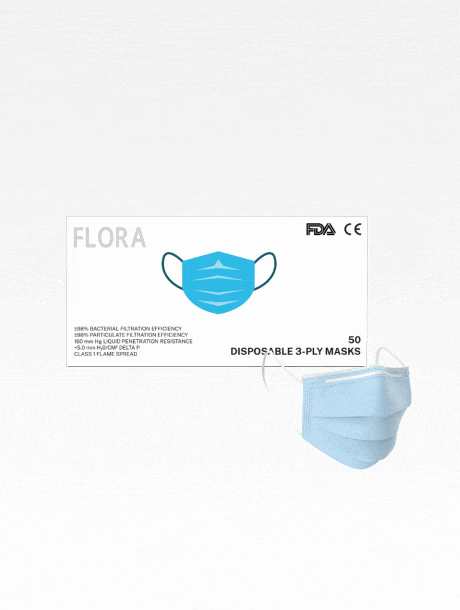It turns out that, a century ago, San Francisco was home to a movement akin to the "liberate" protests that have been going on around the country, in which city residents formed an Anti-Mask League as the 1918 influenza pandemic extended into January 1919.
Yes, San Francisco may be a progressive place where we embrace science and listen to health experts these days, but a century ago, public fatigue with health orders relating to the influenza pandemic in its second wave incited protest — specifically a local order that, just like we instituted here again a little over a week ago, required surgical-type cloth masks in public to help stop the spread of the virulent strain of the flu.
NPR reporter Tim Mak unearthed this tidbit from San Francisco's past and wrote about it in a Twitter thread last week. It comes via newspaper clippings from January 1919, and historical reporting by local author Gary Kamiya, and Alfred W. Crosby in his book America's Forgotten Pandemic: The Influenza of 1918. Mak also drew on the SF Chronicle's archives and the University of Michigan's Influenza Encyclopedia.
THREAD - History doesn't repeat itself, but it rhymes: a thread about the **Anti-Mask League** of 1919.
— Tim Mak (@timkmak) April 19, 2020
I'm not kidding I went HAM researching this
So, starting in Sept 2018 San Francisco suffered from Spanish Flu pandemic.
Initial mask wearing was good -- around 80 percent
The story goes like this: The Dr. Fauci of San Francisco in 1918 was a man named Dr. William C. Hassler. As the second wave of the influenza pandemic began in the fall of 1918, San Francisco was only seeing its first confirmed cases. The first case came on September 24, when a man newly arrived in town from Chicago fell ill. Just weeks later, on October 9, SF had 169 cases. That number ballooned over the course of several weeks. By October 17, Mayor James “Sunny Jim” Rolph was ordering all schools, dance halls, and movie theaters shut down — sound familiar?
Hassler and the Board of Supervisors instituted a mask-wearing ordinance for the city by late October, to which there were citations and fines attached. The public mostly complied into November, at which point cases in SF were down, and public health officials recommended reopening the city on November 21. But cases surged again within weeks, and Hassler tried to re-institute the masking ordinance again, encouraging people to wear masks in early December. City officials voted down his mask ordinance on December 19, and flu cases and deaths surged again — with the peak death count here being December 30.
"The dollar sign is exalted above the health sign," Dr. Hassler reportedly lamented at the time. He even cited some early evidence that the masks had been working. Via Crosby, we know that Hassler tried reasoning with the public, saying, "When the masks were removed [in November], only 10 cases a day were being reported. Nine days later the daily total was reaching 75. And it has increased ever since until now we have had well over 200 [per day] for several days."
Hassler's order was backed up by health organizations, and the City of San Diego had instituted its own mask law at the time.
But ever eager to get back to the party, San Franciscans revolted right on into January, despite the evidence of a new, very serious wave of flu cases and deaths.
On January 10, 1919 there were 600 new cases reported in the city, and officials decided to return to mandatory, versus voluntary, masking. As Mak explains, "Citizens were arrested/fined for not having masks on, but widespread disobedience of the order continue [and] large numbers of citizens refused to wear masks."
Enter the Anti-Mask League, which reportedly held a rally at the "Dreamland Rink" attended by 2,000 people in mid-January in which anti-mask protesters questioned whether the pandemic was really as bad as people said, and whether this wasn't more like a normal cold and flu season.

The protests led to Dr. Hassler being harassed — in one case someone sent him an explosive package, which did not detonate — and both Hassler and Mayor Rolph were photographed not wearing masks themselves. The Chronicle even turned against the mask ordinances, taking the side of the grumpy protesters.
By February 1, they got their wish and the masking order was again rescinded.
Ultimately San Francisco was one of the American cities hardest hit by the Spanish Flu.
— Tim Mak (@timkmak) April 19, 2020
673 per 100,000 people died during the pandemic due to influenza and pneumonia, per U of Michigan.
50K cases total and 3,500 were killed, per Crosby.
San Francisco was reportedly one of the hardest hit cities in the U.S. during the 1918/1919 pandemic. As Kamiya explained in a Chronicle piece a few years ago, "In less than a year, 45,000 people [in San Francisco] fell ill and more than 3,000 died, out of a population of 500,000." But it seems clear that had no health officer been trying to save the public from their own recklessness, the death toll could have been even higher.
And, of course, history repeats itself because human nature is what it is — and pandemics don't, thankfully, come around very often.
We should all be mentally prepared for a phased reopening of the local economy that lasts well into the fall, and be prepared as well to keep wearing our masks for the rest of the year and into the winter to avoid a replay of this second-wave scenario.
Photo of Oakland nurses and volunteers sewing masks via the Oakland Library.


